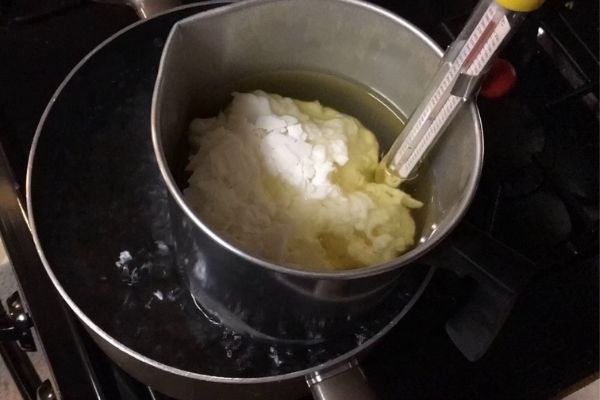If you use soy wax in candle making often, you might have noticed the cloudiness that it could sometimes have. Don’t let it ruin your parade, it’s not such a big deal. However, that might not answer your question, “Why is my soy wax turning cloudy?” But I will, with this article.
You’ll find this guide quite handy, as it will not only cover all you need to know about soy wax turning cloudy, but go an extra mile by answering all your questions on the subject.
Soy wax is a vegetable wax made from soybean oil that is known to burn slowly in comparison with paraffin wax. Hence, it burns for longer and has less soot. However, during the manufacturing process of this wax, some extra moisture and extra air could sometimes get into the wax, and cause it to turn cloudy.

Why soy wax turns cloudy when melting the wax
Normally, while melting your soy wax, it should be clear as the flakes melt. This is how it ought to be, however, on a few occasions, the soy wax might not be clear. Instead, you might notice it turning cloudy, almost the same way it looks when it cools and sets after being poured.
The soy wax turning cloudy is usually dependent on the manufacturing process as stated above. It is caused by the incorporation of air or sometimes moisture, in the wax during the manufacturing process.
We know that the beauty of any candle wax lies in its transparency, and the appearance of a yellow cloud on your wax can be very depressing. But, the cloudiness is just the soy wax trying to correct the defect as it melts by releasing the air that was trapped in it.
You can help by heating the wax at a higher temperature, you don’t have to worry about it affecting your candles performance — it will work just fine.
Why Soy Wax Can Look Cloudy After Cooling
The cloudy look that most soy wax candles have might not always be as a result of a defect in the manufacturing process. There are many other reasons and factors that could be responsible for it, and this includes using wax-coated wicks, embeds, a high temperature of 225°F or more, or even using fragrance oils.
For more information on heating soy wax correctly check out this handy guide that I wrote.
Soy wax can look cloudy after cooling and this is called frosting. Thankfully, it is an aesthetic issue so it can not affect the smell of the candle or the way it burns. Whenever there is a growth of small crystals on the top and at the sides of any soy wax, they form a white-ish and chalky coats at the too and sides of the candle.
Although it might appear unpleasant and make the wax seems to be of less quality, it is a well-known byproduct of most natural wax, so it is a natural phenomena for soy wax to frost. Soy wax always keeps hardening, through the course of its life.
It has been established that it is almost impossible to avoid the formation of frosts, but we need to mention that temperature and time are the two primary factors responsible for this. This is why following the steps below would do a great job in minimising the occurrence of frosting:
- Mix gently: Mixing your melted wax vigorously would not help in reducing the effects of frosting, but mixing gently will. If you mix the melted soy wax aggressively, it’ll hasten the crystallisation process that causes the frosting appearance.
- Use quality Fragrance oils in your candles if you are making scented soy wax candles. Also make sure to use the correct ratio of fragrance oil to wax by using my free fragrance oil and wax calculator.
- Use heated glass containers: Preheating your candle glass containers to ensure they are well warmed before use can help to minimize the effect of frosting. All you need to do is just heat up your candle glass containers ahead of time before pouring melted soy wax into it.
- Add soy wax to candle glass containers at low temperature: When your pour soy wax at low temperature into the glass containers, it helps to effectively reduce the chances of crystal formation when the soy wax hardens later on. This has been proven for scents, soaps and most importantly, candles.
- Don’t hasten the cooling process of your soy wax candles: Always allow your soy wax candles too cool down naturally, at room temperature, in a draft free area. We would advise you to get a wire cooling rack to prevent uneven cooling and also prevent heat transfer.
How to stop your soy wax from turning cloudy
1. Heat the soy wax to its correct temperature
The first step in preventing your soy wax from turning cloudy is heat it up to its correct temperature and hold it at that temperature. Doing this will allow any air or moisture that has been previously trapped within the soy wax to evaporate.
2. Give the wax time to air out
After leaving the wax to stay at the specified temperature, you need to give the wax some time to air out. You can keep the bag open (unsealed) to allow the trapped moisture escape. However, this is highly dependent on the reason behind the cloudy wax i.e. this is particular to cloudy wax that is caused by trapped moisture.
3. Store wax in a cool, dry location
After all these, the temperature at the final stage must also be regulated. We would advise you to store the soy wax in a cool but dry place.
Doing this will help to sieve out any excess moisture and prevent any additional moisture from accumulating in the bag.
CONCLUSION
I trust that this guide will help you to make the right choices and follow the right steps to attain your goals. Soy wax is safe, beautiful and a great choice of wax candles, however they might not always be perfect all the time. As long as this does not affect the quality and scent, then you can go on using them. The advice, instructions, and directions given in this guide are to be followed strictly to achieved your desired results.
- Can You Put Perfume In A Humidifier? (Read First) - September 17, 2022
- Can You Put Essential Oil In A Steam Mop? (Safety Advice) - September 17, 2022
- How To Make Lavender Oil At Home ( Candles And Diffusers) - September 9, 2022

